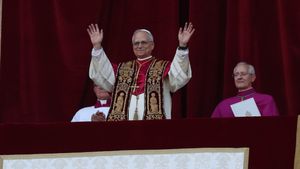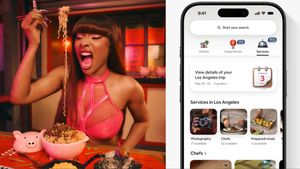(CNN) — For an illness that affects so many people, there are plenty of misconceptions about eating disorders, experts say.
Eating disorders affect nearly 1 in 10 people worldwide, according to the nonprofit ANAD, which provides support services for people with these conditions.
And yet in a culture in which fat shaming and restrictive eating are prevalent, it can be easy for eating disorder behaviors to become normalized, said Jennifer Rollin, founder of The Eating Disorder Center in Rockville, Maryland.
But these conditions threaten both a joyful and healthy life, she added. As Eating Disorders Awareness Week begins, experts share insights into what eating disorders are, what to look for and what to do if you think you see one.
What defines an eating disorder
To put it simply, an "eating disorder is a psychiatric disorder, characterized by found disturbances in eating and feeding behavior that causes significant impairment to one's ability to function normally," said Stuart Murray, an associate professor of psychiatry and behavioral sciences at the University of Southern California and director of the Translational Research in Eating Disorders Laboratory.
More specifically, eating disorders are biopsychosocial illnesses, added Leah Graves, vice president for nutrition and culinary services for Accanto Health, a health system for eating disorder treatment.
Inherited traits as well as psychological factors such as temperament and personality and social factors such as bullying, stigma and trauma come together to contribute to someone developing an eating disorder, she added.
But just because people may have eating disorders in their family and might have inherited predispositions, it doesn't mean they will develop a disorder, Graves said.
What an eating disorder isn't
Eating disorders are not a choice, said Lauren Smolar, vice president of mission and education for the National Eating Disorders Association.
Some may suggest that persons with eating disorders simply change their eating habits and then they will be fixed, but the problem goes much deeper, Smolar said.
Eating disorders can affect anyone, and they are not reserved for young, affluent White women as stereotypes often portray, the USC's Murray said.
They are also not part of a trend or an attempt to lose a few pounds for a wedding or for Instagram photos, Murray added. Attempts to modify shape or weight linked with eating disorders are pervasive and repetitive and have a significant impact on a person's life, he said.
Even if behaviors don't fall under a diagnosable eating disorder, it doesn't mean there isn't a problem. Disordered eating is "a constellation of feeding- and eating-related behaviors that diverge from what's considered typical eating and may cause grave impairments and one's ability to function normally," Murray added.
Anorexia nervosa
Anorexia nervosa is generally characterized by weight loss and commonly involves heavy restriction around the number of calories eaten and an intense fear of gaining weight, according to the National Eating Disorders Association.
Warning signs for this disorder include an overvaluation with shape and weight, strict rules around food, ingredient checking, secrecy and an avoidance of social situations linked with food and body, Murray said.
Bulimia nervosa
Bulimia nervosa is a cyclical condition in which someone binges and then compensates with purging behavior such as vomiting or taking laxatives, according to the association.
Those with bulimia may use the restroom right after a meal or say they are going to go harder at the gym if they have a big meal, Murray said. They may also use laxatives or diuretics, he added.
Binge eating disorder
Binging is one of the most common forms of eating disorders. Someone eats large amounts of food quickly and often to the point of discomfort, the National Eating Disorders Association said.
It sounds like what many of us do from time to time — especially around holidays or special occasions, Murray said. But this disorder is characterized by a loss of control when it comes to eating, he added. And it is surrounded by shame and secrecy.
Avoidant restrictive food intake disorder
Avoidant restrictive food intake disorder, also called ARFID, is one of the newest recognized eating disorders, Accanto Health's Graves said.
This disorder is characterized by avoiding groups of foods, Murray said. It may be misunderstood as "picky eating," but it is a bigger issue, he added.
Those with the disorder may show a lack of interest in eating food, avoid specific sensory characteristics in food or have concerns about the consequences of eating such as vomiting or choking, said Rollin of The Eating Disorder Center.
Typically, people with ARFID have a small range of foods they feel comfortable eating and get distressed going outside that comfort zone, she added.
It can cause problems with having energy or nutritional needs met and may lead to weight loss, faltering growth or issues with psychological and social functioning, Rollin said.
Other feeding and eating disorders
Other specified food, feeding and eating disorders, or OSFED, is a diagnosis given when someone is experiencing a significant eating disorder, but the behavior may not align exactly with the diagnostic criteria of the conditions mentioned above, Smolar said.
There are also behaviors commonly discussed but not yet diagnosed in the medical community.
Orthorexia, for example, is a term used to describe a fixation on eating in a way the person determines to be healthy but is overly rigid and can cause stress in situations when they have to stray from their plans, Rollin said.
Muscle dysmorphia is considered a symptom of body dysmorphic disorder but often describes a pattern in which people have behaviors similar to anorexia or bulimia nervosa such as restricting calories, following rigid rules and doing strenuous exercise as well as monitoring protein intake to achieve a muscular body, Murray said.
How to get help
If you see these concerning behaviors in someone you love, have a compassionate, nonjudgmental conversation explaining what behaviors you are noticing, Graves said.
If you are worried about your own behavior, it is important to seek professional help, Rollin said. She recommended reaching out to therapists who specialize in eating disorders, so they can make evaluations and recommend what other professionals to bring in.
You can also try the National Eating Disorders Association's screening tool designed to help people ages 13 and older determine if it's time to seek help.
The-CNN-Wire
™ & © 2023 Cable News Network, Inc., a Warner Bros. Discovery Company. All rights reserved.


















































